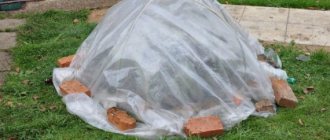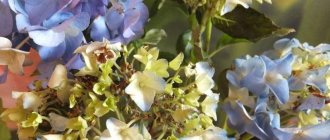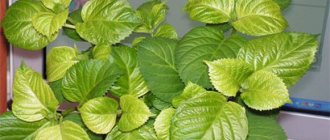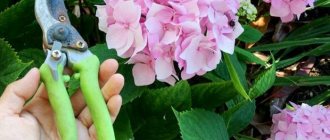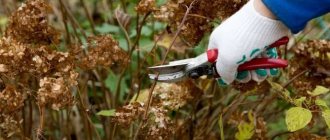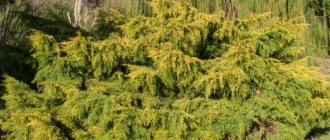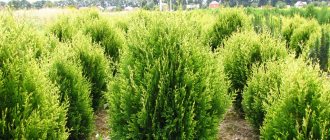Description of Hydrangea largeleaf Miss Saori
Despite the fact that large-leaved hydrangea Miss Saori can reach quite impressive sizes, it looks very elegant. Its branching shoots, capable of growing up to 100 cm, form a neat spherical bush with very large (up to 30 cm in diameter) inflorescences of double flowers of a soft pink hue. The corolla of each flower is formed by two rows of petals with a sharp tip. The blurry dark red border along the edge of each petal gives the flowers a special sophistication and depth. Somewhat less often you can find the pale blue coloring of the corollas.
Attention! Unlike other varieties, the color of hydrangea flowers of this variety does not depend on the acidity of the soil.
The leaves of Miss Saori hydrangea are large, ovoid, glossy. In summer they are dark green with a purple tint, and with the arrival of autumn they acquire a noble burgundy color.
Hydrangea Miss Saori belongs to the remontant varieties, that is, flower buds are formed on last year's shoots. The flowering period is long, lasting from the second half of summer until almost mid-autumn.
Why is the variety attractive?
Hydrangea Miss Saori is a very unusual variety, interesting for its sophistication. A distinctive feature is an interesting play of colors: large white matte flowers, placed on powerful, beautiful stems, look very harmonious against the backdrop of rich green foliage with a slight purple tint.
Interestingly, the Miss Saori variety retains its color range regardless of the acidity of the soil in which it is planted. The decorative period is very long and lasts from June to September inclusive. The height of the bush can reach one meter and therefore can become a very extraordinary decoration for any garden plot or greenhouse.
Hydrangea Miss Saori in landscape design
This representative of the Hortensia family can become a real pearl of the garden. In landscape design, spherical plants create the illusion of increasing space, so even in small areas, Miss Saori hydrangea will look advantageous.
Thanks to its classic shape, this flower will organically fit into the landscape of any style. It can be used for landscaping urban areas, parks and other recreational areas, as well as for decorating private gardens. Hydrangea of this variety can grow in single plantings or be a bright accent in group flower ensembles. It is often combined with other varieties of shrubs. It is also suitable for growing in containers, without compromising the flowering quality.
Miss Saori hydrangeas planted in ceramic vases and pots look very noble
To trim or not
As a rule, most large-leaf hydrangea varieties cannot be pruned. Remontant varieties also produce flowers on last year's shoots, and new shoots grow from the axils of old ones. Therefore, pruning can have a bad effect on the decorative qualities of the flower.
However, pruning does not affect the condition of the plant itself. If you need to shorten the vines to create a landscape design or a certain variety requires it, then feel free to take a pruner. It is also necessary to monitor the safety of the shoots and remove damaged or frozen parts in a timely manner. It is best to prune last year's shoots in early spring. During the year, if necessary, you can correct only young shoots.
As you can see, hydrangea, despite its tropical origin, is quite capable of living in continental and temperate climates. The main thing is not to forget about watering, apply fertilizers on time, and then the plant will gratefully give you stunningly beautiful flowers.
Planting and caring for Miss Saori hydrangea
In order for the Miss Saori hydrangea to please the eye with long and abundant flowering, it is necessary to choose the right planting site, ensuring proper care in the future.
Selection and preparation of a landing site
Hydrangea Miss Saori prefers partial shade or areas with diffused sunlight, protected from the winds. In the shade it blooms later, and in the sun the flowers can become noticeably smaller. The soils suitable for this variety of hydrangea are fertile, loose, retain moisture well, but not waterlogged, preferably with an acidic reaction. On calcareous and alkaline substrates, the flower loses its decorative effect.
Landing rules
Miss Saori hydrangea is planted in early spring, when night temperatures reach positive values. Plants are placed at a distance of at least 150 cm from each other.
Planting Miss Saori hydrangea involves the following sequence of actions:
- dig planting holes 40 cm deep, about 30 cm long and wide;
- the soil is mixed with sand and humus, nutrients are added;
- the pit is well watered;
- when placing the bush, the root collar is left above the soil surface;
- the pit is filled with the resulting nutrient mixture;
- the plant is watered abundantly;
- the tree trunk circles are mulched with sawdust or pine needles.
Watering and fertilizing
Timely, regular watering is one of the main conditions for preserving the excellent decorative qualities of the Miss Saori hydrangea. This is a moisture-loving plant, so it needs to be watered as the top layer of soil dries, but so that the water does not stagnate at the roots. Mulched bushes require less moisture. It is best to use settled water for irrigation.
Attention! If the hydrangea bush grows in a sunny area, the amount of watering should be increased.
Fertilizers are applied three times per season:
- in spring, at the beginning of the active growth phase;
- in mid-summer, in the bud formation phase;
- in the last weeks of summer, before preparing plantings for winter.
It is best to use highly diluted manure as an organic fertilizer. In addition, hydrangea needs potassium and phosphorus fertilizers. Fertilizing with nitrogen compounds can be carried out only until mid-summer, so as not to stimulate the growing season before the plant goes into dormancy.
Pruning Hydrangea largeleaf Miss Saori
In order for the hydrangea to bloom magnificently and abundantly, you should cut off the branches without flower buds, leaving only one lower bud, from which a new flowering shoot will appear next season.
To preserve the decorative effect, dry inflorescences must be removed after flowering is completed.
Preparing for winter
Shelter is a prerequisite for growing this shrub in areas with cold winters. In the conditions of the middle zone, it is enough to mulch the circle around the trunk and cover the ground with spruce branches. In the northern regions, bushes are additionally removed under a special covering material.
If hydrangea grows in a container, for the winter it is transferred to a room with a temperature of +3-5 °C, for example, to a basement. From time to time, the earthen ball is watered.
Hydrangea largeleaf Miss Saori
Plants with this shipping deadline are sent out from April 1 to May 30 in the order in which orders are received.
Plants with only one delivery date !
You save: 365 ₽
For all planting material
Dozens of payment methods
Fast and convenient delivery
Russian Post (Moscow and region within 24 hours), SDEK, Courier
Large leaf hydrangea Miss Saori (Miss Saori).
Double flowers, white and pink bicolor, slightly wavy edges. The foliage is dark green with a purple tint. The stems are strong. Suitable for cutting. 1st place in Chelsea 2014 RHS Chelsea Plant of the Year. Received in Kyoto, Ryoji Irie, 2014, named after Breder's bride. Blooms from July until frost. Shrub 1–2 m high. When grown in containers, it has a height of 0.4 - 0.6 m. In large-leaved hydrangea, last year's shoots are woody, this year's shoots are green and herbaceous, and only become woody next year. This leads to weak cold resistance of large-leaved hydrangeas (up to -23). Like the rest, large-leaved hydrangeas bloom at the ends of annual shoots. But unlike other types of hydrangeas, not all annual shoots may end in flowers, but mainly those grown from the few upper buds of the previous year's shoots. Therefore, it is usually said that large-leaved hydrangea blooms on last year’s shoots. Requires shelter for the winter.
Planting hydrangea: It is necessary to dig a hole 40 - 50 cm deep and 40 cm in diameter. If the hydrangea bushes or shoots are small, it can be made a little smaller. The prepared seedling must be placed in the center of the planting hole so that its root collar is not too deep. The plant around the plant should be carefully covered with soil and compacted so that the roots are well pressed and no voids form around them.
Caring for hydrangea: Caring for hydrangea comes down primarily to proper watering, timely fertilizing, pruning and loosening. If you do everything correctly, the bushes will be lush and the inflorescences will be large and bright.
Soil for planting: The soil for hydrangea should be well-drained and moist, consist of a balanced mixture of humus, leaf soil, peat chips, river sand (2:2:1:1). Regardless of the type and variety of hydrangea, remember that lime in the soil negatively affects development.
Preparing for winter: Large-leaved hydrangea Miss Saori (Miss Saori) is a heat-loving plant, so it needs to be protected in the winter season. Young shoots and insufficiently winter-hardy varieties need special protection. If the bush is very young, you can simply cover it on top with earth, fallen leaves or sawdust. Older plants must be bent to the ground and covered with roofing material or lutrasil. To prevent the wind from blowing it away, you need to press down the covering material with bricks. Mature bushes require more careful shelter. You have to try not to break them.
Reproduction
You can get new Miss Saori hydrangea plants from seeds or vegetatively - by cuttings or layering.
When propagating by seed, planting material is sown immediately in open ground in March. Seeds do not need stratification.
One of the most popular methods of propagation is rooting cuttings from the mother bush. In the spring, shallow trenches are dug under an adult specimen and oblique cuts are made on the underside of the shoots to stimulate root formation. Then they are bent down, secured in the trench with wire staples and sprinkled with a mixture of fertile soil and peat. They are watered regularly throughout the season. To prevent the soil from drying out, it is recommended to cover the layering with film. The following spring, rooted shoots are separated from the mother bush and transplanted to a permanent place.
Hydrangea Miss Saori can be propagated from cuttings. In mid-summer, young green shoots the size of a pencil are cut and all leaves (except the top pair) are removed. The lower cut is treated with a root formation stimulator and planted at an angle of 45° in a mixture consisting of soil, river sand and peat. It is most convenient to root cuttings in boxes under film to ensure high humidity.
Diseases and pests
Most often, hydrangea diseases are caused by the wrong choice of location and lack of proper care for the plant. With a lack of nutrients in the soil, prolonged exposure to direct sunlight, drying out or waterlogging of the substrate, the leaves of the shrub begin to dry out and fall off, brown spots may appear on them, and the inflorescences become smaller and deformed. These problems can be solved by eliminating unfavorable environmental factors.
Fungal diseases pose a great danger to shrubs - gray rot, downy mildew, powdery mildew, septoria. Plants can be cured with an aqueous solution of soap and copper sulfate or fungicides.
The most dangerous is ring spotting, which cannot be treated. Hydrangea infected with this viral disease dies. Affected plants should be promptly removed and burned to prevent pathogens from spreading to healthy plantings.
Ring spot is characterized by the appearance of round spots with dead cells on the leaves.
Diseases are often transmitted by insects - aphids, spider mites and root-knot nematodes. At the first sign of an invasion by these pests, plants should be treated with insecticides.
To protect hydrangea from rot, it is recommended to water the seedlings of the first year of planting with a weak solution of potassium permanganate. To prevent fungal diseases, the bushes are treated with Bordeaux mixture before winter.
